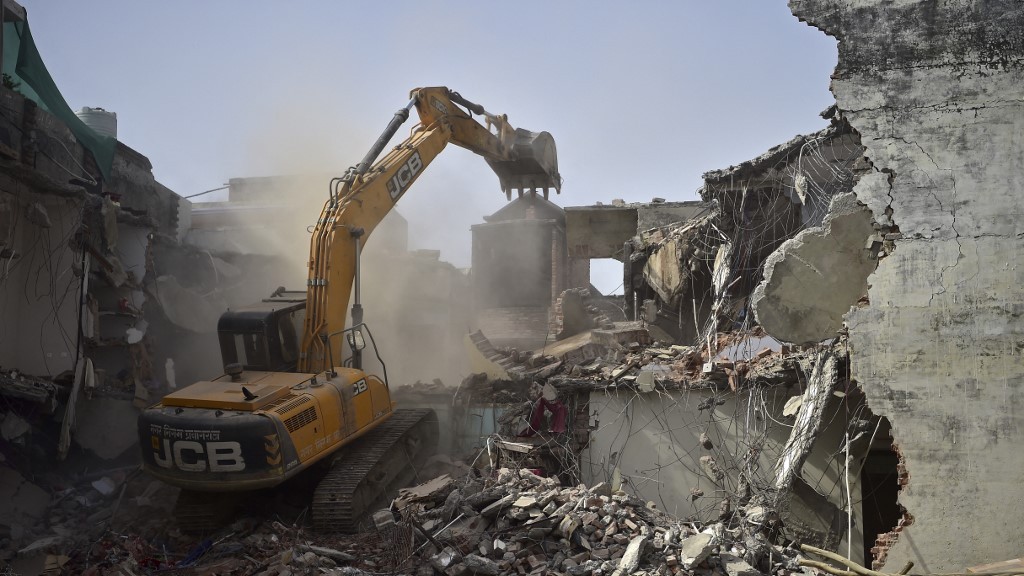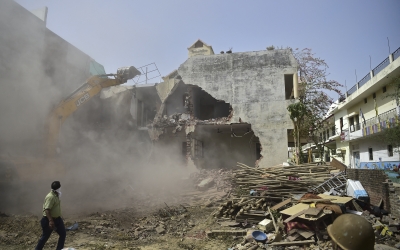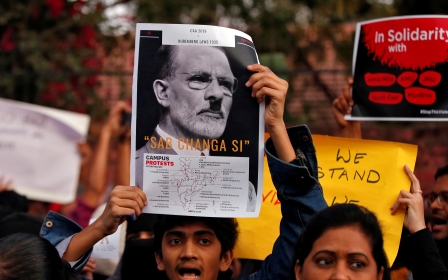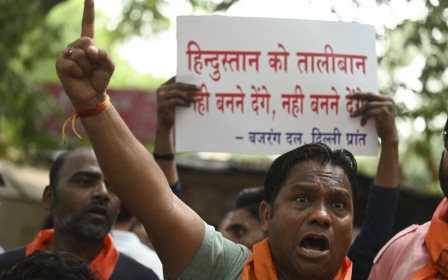India's bulldozer war on Muslim neighbourhoods
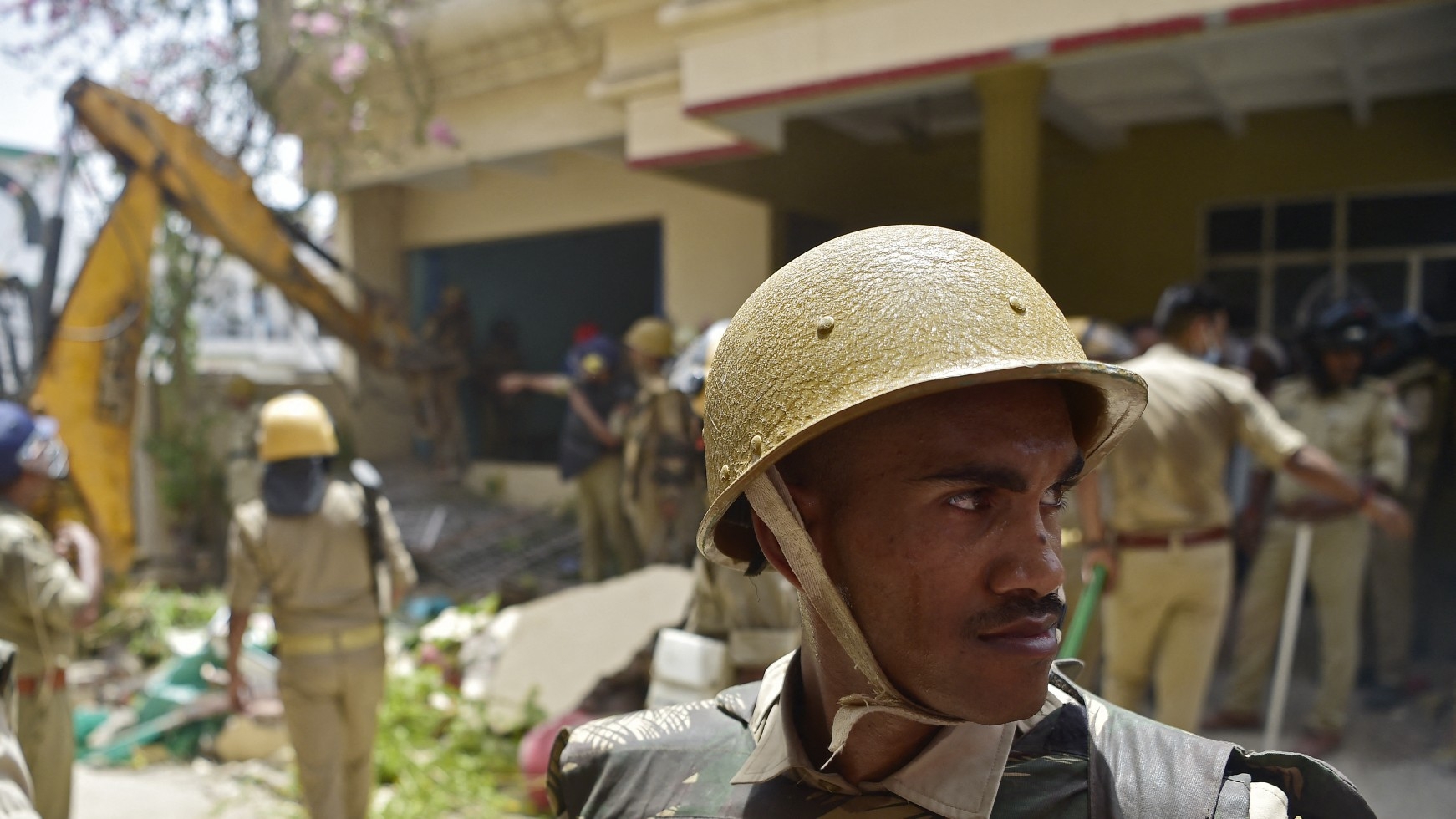
Hundreds of Muslim residents of Haldwani, in India's northern state of Uttarakhand, protested for days, braving the winter cold, after an Indian court ordered the demolition of more than 4,000 homes over allegations they were encroaching on railway land. While last month the country’s Supreme Court issued a stay on the order, which could affect 50,000 people, it has not yet ruled on the issue of land ownership.
While the scale of this demolition drive is uniquely massive, it is not the first of its kind. Last year, Muslim properties were targeted for demolition in Uttar Pradesh, Madhya Pradesh, New Delhi, Gujarat and other areas, with the pretext generally being “illegal encroachment”.
If we stop existing on the map, do we still exist in the political community as participants?
The abrupt nature of demolition drives, leaving little room for legal investigations, is profoundly altering how Muslims perceive normal life in India, blurring the lines between public and private space. The demolitions cause Muslims economic harm, while also damaging their political standing.
Somehow, a belief seems to exist that violence against Muslim homes is less severe than violence against bodies - a form of “collateral damage” that demands no urgent action. But this ignores the political dimension of home demolitions, which aim to eliminate the targeted group’s ability to survive.
In the Haldwani case, national media adopted a nefarious narrative framing the Muslim protesters as a “jihadi gang” - a conspiracy theory that has been deployed against other Muslims, using the false claim that they are illegally occupying Hindu lands. In recent years, the policy of demolitions has become an inseparable part of the ruling BJP’s administrative discourse.
New MEE newsletter: Jerusalem Dispatch
Sign up to get the latest insights and analysis on Israel-Palestine, alongside Turkey Unpacked and other MEE newsletters
And the road from homelessness to statelessness is not as long as some would like to imagine. If we stop existing on the map, do we still exist in the political community as participants? And if we don’t exist in the political community, what keeps us from becoming mere abstractions?
Narrative of 'encroachers'
While measures such as India’s Citizenship Amendment Act and the National Register of Citizens threaten Muslims’ legal status as citizens in the nation, the narrative of “encroachers” seeks to develop a similar link of criminality, with Muslims portrayed as “illegally” grabbing lands that legitimately belong to Hindus. The state of Uttarakhand, which includes Haldwani, has been the focus of strong Hindutva propaganda promoting it as the “land of the gods”, further pushing the concept that the Muslims who live there are outsiders.
It is not by accident that during the Covid-19 pandemic, Hindutva nationalists claimed that Muslim neighbourhoods were responsible for spreading the virus in India. It was described in the national media as “corona jihad”. Demeaning terms such as “termites”, “cockroaches” and “leeches” are also part of the Hindutva lexicon regularly deployed against Muslims. The act of destroying Muslim homes is thus presented to the masses as a necessary act.
BJP politics heavily rely on pushing a reimagination of Indian land as sacred Hindu territory under a perpetual threat of violation by Muslim “invaders”. Yet, while this narrative has gained massive popularity in recent years, its roots are much deeper. Important figures who laid the foundations of Hindu nationalism, especially Vinayak Damodar Savarkar and M S Golwalkar, emphasised the cultural elimination of Muslim spaces as a necessary step towards fulfilling nationalist goals.
As the popularity of Hindu nationalism has grown, so too has the violent reassertion of a monopoly over public spaces, challenging a pluralistic conception of Indian land. Hindu nationalists have led campaigns against public Muslim prayers and the use of mosque loudspeakers for the adhan.
Physical space has become not just a target for Hindu nationalists, but also the very medium through which an undeclared internal war is being fought against Indian Muslims. While a traditional war is waged on the battlefield, this one seeps into every aspect of its targets’ lives, turning even the most mundane moments into conflicts and militarising everyday life.
Events transformed
To understand this phenomenon, one needs only to look at the transformations that the most banal events have undergone. 2022 witnessed a massive change in how Hindu religious rallies and processions are being organised, with celebrations marking Ram Navami and Hanuman Jayanti divorced from their religious origins and repurposed as occasions for anti-Muslim political demonstrations of dominance and ownership.
Mobs of men rampaged through Muslim neighbourhoods brandishing weapons and chanting genocidal slogans, leading to confrontations in some cases. The neighbourhoods that exhibited minimal retaliation were met with a strong state response, as properties were bulldozed and families left homeless.
In several such rallies, Hindu mobs reportedly tried to plant saffron flags atop mosques, comparable to marking conquests in enemy territory - a historical method of claiming ownership or sovereignty over an area.
While laying the foundation stone for the Ganga Expressway in Uttar Pradesh in December 2021, Prime Minister Narendra Modi endorsed bulldozer politics, saying: “When the bulldozer runs over the mafia … the bulldozer runs over the illegal building, but the person who is nurturing it feels the pain.”
This speaks to a crucial aspect of the motivation behind the policy of demolitions, which is not to attack people physically, but rather on a psychological level, depriving them of any hope for a safe future.
Architecture, through its illusion of permanence, allows community members to imagine themselves both in the past and in a future that extends beyond the lifetime of their bodies. With the collapse of whatever is built, that link, which reaffirms our belonging to the land, also collapses.
Discriminatory policies
The emptiness that remains after the bulldozer leaves is replete with contradictions: the absence of meaning left in the debris, and an overwhelming political significance. The space becomes testament to political power exercised in excess. What was once a home for a family becomes a public artifact of nothingness for the city to behold - an aggressive reminder to Muslims that they no longer hold the right to a private life.
In a country that has socially ostracised Muslims, it is not difficult to calculate the devastation that can follow from losing their shelter. The ambiguous legal status of such acts also makes it much more difficult to fight back.
Muslims must choose between a life of humiliation or a death of humiliation
The people most affected by targeted demolitions in the Muslim community are those who are already economically disadvantaged and lack the resources and power to retaliate. At the same time, individuals within the Muslim community who openly speak out against the government’s discriminatory policies become prime targets.
Essentially, law and order are suspended temporarily at the whims of state authorities. And a larger message is being sent to Muslims: that the state does not necessarily protect them. Demolitions should thus be seen for what they truly are, and that is not just an attack on the walls of a home. It is not solely the rights of Muslims that are under attack, but rather, as philosopher Hannah Arendt framed it, their “right to have rights” and to defend themselves.
With the introduction of bulldozers, the government no longer has to say with clarity what is acceptable behaviour. Rather, it can simply push a narrow framework of possibilities, where Muslims must choose between a life of humiliation or a death of humiliation.
The views expressed in this article belong to the author and do not necessarily reflect the editorial policy of Middle East Eye.
Middle East Eye delivers independent and unrivalled coverage and analysis of the Middle East, North Africa and beyond. To learn more about republishing this content and the associated fees, please fill out this form. More about MEE can be found here.



